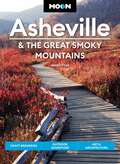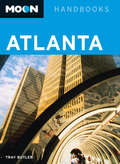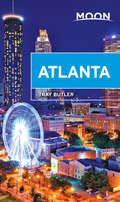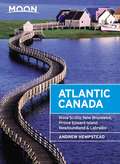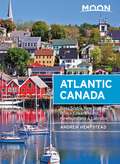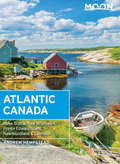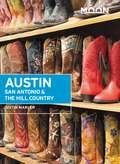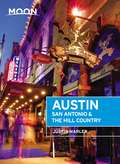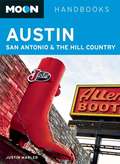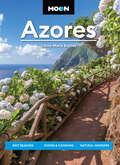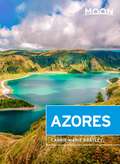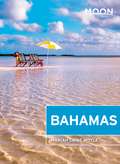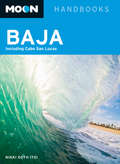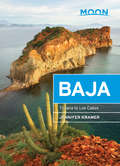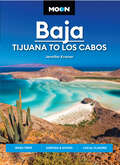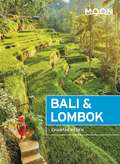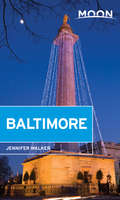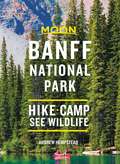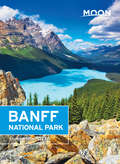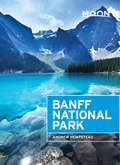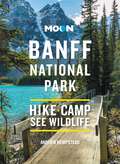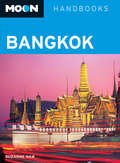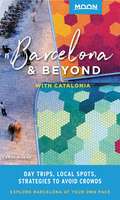- Table View
- List View
Moon Asheville & the Great Smoky Mountains: Craft Breweries, Outdoor Adventure, Art & Architecture (Travel Guide)
by Jason FryeWhether you're hopping between microbreweries or hiking the Appalachian Trail, get to know this charming Southern hub with Moon Asheville & the Great Smoky Mountains. Inside you'll find:Flexible, strategic itineraries, whether you have a week to explore or just one day, designed for outdoor adventurers, foodies, history buffs, and more The best local flavor: Indulge in award-winning cuisine on a food tour, discover the microbreweries that earned Asheville the title of "Beer City USA," and catch a live show from a local band. Admire the art deco architecture downtown, gallery-hop in repurposed warehouses, or check out an indie bookstore Unique outdoor experiences: Hike through the mountains and meadows along the Appalachian Trail, take a dip in the hot springs dotting the hillsides, or break out the binoculars for some top-notch wildlife-watching. Set up camp in the Pisgah National Forest, peep the changing leaves in autumn, or go rafting, kayaking, or canoeing on the French Broad River Honest advice on when to go, where to stay, and how to get around from North Carolina local Jason Frye Full-color photos and detailed maps throughoutThorough background on the culture and history, wildlife, and geography Find your adventure with Moon Asheville & the Great Smoky Mountains. Expanding your trip? Try Moon North Carolina. Looking for more Southern charm? Try Moon Charleston & Savannah. About Moon Travel Guides: Moon was founded in 1973 to empower independent, active, and conscious travel. We prioritize local businesses, outdoor recreation, and traveling strategically and sustainably. Moon Travel Guides are written by local, expert authors with great stories to tell—and they can't wait to share their favorite places with you. For more inspiration, follow @moonguides on social media.
Moon Atlanta
by Tray ButlerSkilled writer-journalist Tray Butler offers up his best advice on Atlanta-from the bustling financial Downtown district to the historical draw of Sweet Auburn and the fabulous food and arts of Decatur. Butler includes unique trip strategies for a variety of travelers, such as The Two-Day Best of Atlanta and Food to Please the Soul. Including expert coverage of Centennial Olympic Park, the Martin Luther King Jr. National Historic Site, the World of Coca-Cola, and Zoo Atlanta, Moon Atlanta gives travelers the tools they need to create a more personal and memorable experience.
Moon Atlanta (Moon Handbooks)
by Tray ButlerSkilled writer and journalist Tray Butler offers up his best advice on enjoying Atlanta, from the bustling financial Downtown district to the fabulous flavors of Little Five Points and East Atlanta and beyond. Butler offers unique trip strategies for a variety of travelers, such as "The Two-Day Best of Atlanta" and "New South, Old Flavors. " Including expert coverage of the Martin Luther King Jr. National Historic Site, the Atlanta Botanical Garden, the World of Coca-Cola, and Zoo Atlanta, Moon Atlanta gives travelers the tools they need to create a more personal and memorable experience.
Moon Atlantic Canada
by Andrew HempsteadTravel writer and Canada expert Andrew Hempstead offers unique insight into this historic corner of the North American coast, from swimming in the warm waters of Northumberland Strait to exploring bustling downtown Moncton and its lively nightclubs. Hempstead includes unique trip strategies that connect with travelers' specific interests, such as Rugged Atlantic Canada-an outdoors-oriented itinerary-and Atlantic Canada's Best in One Week, for those who want to see all four provinces but only have a week to spare. With information on how to find the freshest seafood, where to hang out on America's oldest street, and when to get the best views at Peggy's Cove, Moon Atlantic Canada gives travelers the tools they need to create a more personal and memorable experience.
Moon Atlantic Canada: Nova Scotia, New Brunswick, Prince Edward Island, Newfoundland & Labrador (Travel Guide)
by Andrew HempsteadYour World Your Way Travel writer and Canadian Andrew Hempstead shares his expert perspective on Atlantic Canada, guiding you to a memorable and unique experience. Whether you're hoping to kayak to beautiful islands for a picnic lunch, go whale-watching, enjoy the hospitality and culture of the locals, or taste the freshest seafood, Moon Atlantic Canada has activities for every traveler. With itineraries like "Best of Atlantic Canada” and "Fresh from the Sea,” expertly crafted maps, gorgeous photos, and Hempstead's trustworthy advice, Moon Atlantic Canada provides the tools for planning your perfect trip!Moon Atlantic Canada covers can't-miss sights and the best destinations including: Nova Scotia New Brunswick Prince Edward Island Newfoundland and Labrador
Moon Atlantic Canada: Nova Scotia, New Brunswick, Prince Edward Island, Newfoundland & Labrador (Travel Guide)
by Andrew HempsteadFrom rugged coastline and uninhabited islands, to charming seaside towns full of friendly locals, experience the best of this adventurous region with Moon Atlantic Canada. Inside you'll find:Strategic, flexible itineraries including scenic drives, aquatic adventures, and the two-week best of Atlantic Canada, designed for outdoor enthusiasts, families, history buffs, and moreUnique experiences and outdoor experiences: Kayak to a remote island for a picnic lunch, or sample local oysters at a waterfront restaurant. Drive the Cabot Trail or the Irish Loop and take in the stunning scenery, or bike through UNESCO protected towns. Relax at quaint colonial inns, or camp out under the stars. See if you can spot one of the world's rarest whales, or indulge your literary side by visiting sights from Anne of Green GablesExpert advice from local Andrew Hempstead on when to go, where to stay, and how to get aroundFull-color photos and detailed maps throughoutIn-depth coverage of Nova Scotia, New Brunswick, Prince Edward Island, Newfoundland, and LabradorBackground information on the landscape, culture, history, and environmentWith Moon's practical tips and local insight on the best things to do and see, you can experience the best of Atlantic Canada.Sticking to one province? Check out Moon Nova Scotia, New Brunswick & Prince Edward Island.
Moon Atlantic Canada: Nova Scotia, New Brunswick, Prince Edward Island, Newfoundland & Labrador (Travel Guide)
by Andrew HempsteadCatch a glimpse of the world's rarest whales, hike through lush forests, or wander around quaint historic towns: the very best of the northeast is yours with Moon Atlantic Canada. Inside you'll find:Strategic, flexible itineraries including scenic drives, ocean excursions, and the best of Atlantic CanadaTop experiences and activities: Take in stunning scenery while driving the Cabot Trail or the Irish Loop, visit an active archeological dig at the Colony of Avalon, or study artifacts from the Titanic at the Maritime Museum of the Atlantic. Savor local oysters at a waterfront restaurant, sample seasonal beers at North America's oldest operating brewery, and refuel with a hearty rappie pie after a day of touring Nova Scotia. Relax at cozy a colonial inn or listen to live jazz at a neighborhood pub Best outdoor adventures: Bike through UNESCO-protected towns or cruise past massive icebergs. Cross-country ski and snowmobile in Sugarloaf Park or skate on frozen lakes near Halifax. Hike along rocky shoreline or through wildflower-filled river valleys. Kayak to a secluded island for a picnic lunch and camp out under the stars at oceanside parksExpert advice from local Andrew Hempstead on when to go, where to stay, and how to get aroundFull-color photos and detailed maps throughoutBackground information on the environment, culture, and historyIn-depth coverage of Nova Scotia, New Brunswick, Prince Edward Island, Newfoundland, and LabradorGet to know the best of Atlantic Canada with Moon's local insight, expert tips, and unique experiences.Sticking to one province? Check out Moon Newfoundland & Labrador or Moon Nova Scotia, New Brunswick & Prince Edward Island. About Moon Travel Guides: Moon was founded in 1973 to empower independent, active, and conscious travel. We prioritize local businesses, outdoor recreation, and traveling strategically and sustainably. Moon Travel Guides are written by local, expert authors with great stories to tell—and they can't wait to share their favorite places with you.For more inspiration, follow @moonguides on social media.
Moon Austin, San Antonio & the Hill Country (Travel Guide)
by Justin MarlerEmbrace your inner cowboy and discover the heart of the Lone Star State with Moon Austin, San Antonio & the Hill Country. Inside you'll find:Flexible itineraries, from a long weekend in Austin to a road trip through Hill CountryStrategic advice for music lovers, history buffs, families, and moreUnique and authentic experiences: Two-step at a local honky-tonk, or explore the folk and contemporary art scenes. Catch a live show in one of Austin's countless famed venues, or a UT Longhorn game in a jam-packed stadium. Hike or bike around the many trails, lakes, and streams of Hill Country, or spot roaming bison and antelope on your way to a local winery. Explore the rich Latino heritage of San Antonio and visit the historic Alamo Expert tips from Austin local Justin MarlerHonest advice on where to stay, where to eat (including the best BBQ joints!), and how get around by car or public transportationFull-color photos and detailed maps throughoutDetailed and thorough information, including background on culture and history, geography, and regional vernacularExperience the best of Texas with Moon Austin, San Antonio & the Hill Country.Looking to explore more of the Lone Star State? Try Moon Dallas & Fort Worth or Moon Texas.
Moon Austin, San Antonio & the Hill Country: San Antonio And The Hill Country (Travel Guide)
by Justin MarlerMusician and freelance writer Justin Marler offers his insider's perspective on Austin, San Antonio, and Texas's Hill Country, including where to take a leisurely stroll, rock-climb in the great outdoors, or catch a live show. Marler shares unique travel strategies like Texas Pride, Family Fun in San Antonio, and Hill Country Road Trip#151;an itinerary that will take you on a whirlwind horseback-riding, antiques-hunting, and wine-tasting tour. With expert advice on exploring the region's most interesting historic sights and dining on the best Tex-Mex money can buy, Moon Austin, San Antonio & the Hill Country gives travelers the tools they need to create a more personal and memorable experience.
Moon Austin, San Antonio and the Hill Country
by Justin MarlerMusician and freelance writer Justin Marler offers his insider's perspective on Austin, San Antonio, and Texas's Hill Country, including where to take a leisurely stroll, rock-climb in the great outdoors, or catch a live show. Marler shares unique travel strategies like Texas Pride, Family Fun in San Antonio, and Hill Country Road Trip-an itinerary that will take you on a whirlwind horseback-riding, antiques-hunting, and wine-tasting tour. With expert advice on exploring the region's most interesting historic sights and dining on the best Tex-Mex money can buy, Moon Austin, San Antonio & the Hill Country gives travelers the tools they need to create a more personal and memorable experience.
Moon Azores: Best Beaches, Diving & Kayaking, Natural Wonders (Travel Guide)
by Carrie-Marie Bratley Moon Travel GuidesExperience the breathtaking and unspoiled islands that await just a short hop from mainland Portugal with Moon Azores. Inside you'll find:Strategic, flexible itineraries for exploring individual islands or combining them into a longer trip, with coverage of Porto and Lisbon The top outdoor adventures: Cave-dive into the depths of an extinct volcano, soak in a steaming hot spring, and catch some sun on Santa Maria's golden sand beaches. Dive or snorkel in crystalline waters filled with shipwrecks and colorful marine life. Spot dolphins, humpback whales, and more on an island cruise and go bird-watching on a lush São Jorge fajã. Hike to stunning viewpoints above Sete Cidades Lake or summit the epic, snow-capped Mount Pico Must-see highlights and unique experiences: Stroll through sprawling gardens and secret grottoes in Terra Nostra Park or sip Gorreana tea at Europe's only tea plantation. People watch over a cup of coffee in the UNESCO historical center of Angra do Heroísmo or admire the famous mariner murals in Horta Marina. Savor fresh seafood and local charcuterie in a seaside village, browse traditional cheeses at a morning market, and sample basalt wines Expert advice from long-time Portugal resident Carrie-Marie Bratley Full-color photos and detailed maps throughoutBackground information on the landscape, history, and cultural customs of the islands Handy tools such as visa information, a Portuguese phrasebook, and tips for LGBTQ+ travelers, seniors, families, and more With Moon's practical tips and local know-how, you can experience the best of the Azores. Heading to the mainland? Check out Moon Portugal.About Moon Travel Guides: Moon was founded in 1973 to empower independent, active, and conscious travel. We prioritize local businesses, outdoor recreation, and traveling strategically and sustainably. Moon Travel Guides are written by local, expert authors with great stories to tell—and they can't wait to share their favorite places with you. For more inspiration, follow @moonguides on social media.
Moon Azores: With Madeira & The Azores (Travel Guide)
by Carrie-Marie BratleyExperience the breathtaking and unspoiled islands that await just a short hop from mainland Portugal with Moon Azores. Inside you'll find:Strategic, flexible itineraries for exploring individual islands or combining them into a longer trip, with coverage of Porto and LisbonThe top outdoor adventures: Cave-dive into the depths of an extinct volcano, soak in a steaming hot spring, and catch some sun on Santa Maria's golden sand beaches. Dive or snorkel in crystalline waters filled with shipwrecks, submerged volcanoes, seamounts, and colorful marine life. Spot dolphins, humpback whales, and more on an island cruise and go bird-watching on a lush São Jorge fajã. Hike to stunning viewpoints above Sete Cidades Lake or summit the epic, snow-capped Mount PicoMust-see highlights and unique experiences: Wander past cobbled squares and whitewashed buildings to marvel at the striking Old Gates of Ponta Delgada. Stroll through sprawling gardens of exotic plant and secret grottoes in Terra Nostra Park or sip authentic Gorreana tea at Europe's only tea plantation. People watch over a cup of Azorean coffee in the UNESCO historical center of Angra do Heroísmo or admire the famous mariner murals in Horta Marina. Savor fresh seafood and local charcuterie in a seaside village, browse traditional cheeses at a morning market, and sample basalt wines on PicoExpert advice from long-time Portugal resident Carrie-Marie BratleyFull-color photos and detailed maps throughoutBackground information on landscape, history, and cultural customs of the islandsHelpful resources on COVID-19 and traveling to the AzoresHandy tools such as visa information, a Portuguese phrasebook, and tips for LGBTQ+ travelers, seniors, families, and moreWith Moon's practical tips and local know-how, you can experience the best of the Azores. Heading to the mainland? Check out Moon Portugal.
Moon Bahamas (Travel Guide)
by Mariah Laine MoyleTurquoise waters, pristine beaches, world-famous rum, and a culture that welcomes you with a smile: Soak up the sun and fun with Moon Bahamas. Inside you'll find:Flexible itineraries, from a Nassau getaway to a week of island-hopping, including day trips to the Out Islands Strategic advice for travelers looking for family fun, romance, nightlife, water sports, and moreMust-see highlights and unique experiences: Go diving to see shipwrecks, underwater sculptures, and coral reefs, snorkel with sharks, or swim with friendly pigs. Spot wild pink flamingoes, climb to a historic stone monastery at the highest point in the Bahamas, or visit the iconic Hope Town Lighthouse. Relax in an oceanfront bungalow, sip cocktails made from local rum, and hang out with locals at a fish fryHonest recommendations from Nassau local Mariah Moyle on when to go, where to eat, how to get around, and where to stay, from guest cottages and beach bungalows to luxurious resortsFull-color photos and detailed maps throughout Background information on the landscape, climate, wildlife, and history Handy tips for families with children, LGBTQ travelers, seniors, and travelers with disabilitiesExperience the real Bahamas with Moon's practical tips and local know-how.Looking for more island adventures? Check out Moon Aruba, Moon Bermuda, or Moon Jamaica.
Moon Baja
by Nikki Goth ItoiSeasoned writer and Mexico enthusiast Nikki Goth Itoi knows the best way to experience Baja-from exploring Valle de Guadalupe, Baja's wine country, to riding the waves at the region's premiere surfing spots. Itoi offers a variety of suggested travel strategies, including Island Hopping, Around the Cape in Seven Days, and Seaside Romance. Complete with tips on fishing and kayaking in Loreto and information on evening Art Walks in San José del Cabo, Moon Baja gives travelers the tools they need to create a more personal and memorable experience.
Moon Baja: Including Cabo San Lucas (Travel Guide)
by Jennifer KramerMake your Escape with Moon Baja! Baja California has a little bit of everything: warm, turquoise ocean and white-sand beaches, rugged desert mountain ranges, and cities bursting with art, culture, and delicious cuisine. Immerse yourself in the unique culture of this welcoming and colorful peninsula with Moon Baja.What You'll Find in the Moon Baja travel guidebook:Curated advice from local writer and tour guide Jennifer Kramer, who has spent nearly 30 years sharing all that Baja has to offerFull-color with vibrant, helpful photosDetailed directions and maps for exploring on your ownIn-depth coverage of Tijuana, Ensenada, and Valle de Guadalupe, Mexicali, San Felipe, and Sierra de Juárez, San Quintín and Bahía de los Ángeles, Guerrero Negro and El Vizcaíno, Loreto and Bahía Magdalena, La Paz, The East Cape and the Sierra de la Laguna, Los Cabos, and Todo Santos and the West CapeActivities and ideas for every traveler: Cruise down Mexico's Highway 1 with endless desert as a backdrop and the warm Baja breeze in your face. Sip a cerveza from your hammock, or take a panga ride out to see dolphins, whales, and sharks in the Sea of Cortéz. Go wine or beer tasting in Ensenada, sample the freshest fish tacos on the beaches of Los Cabos, or shop for beautiful artisan goods in Loreto. Watch the sun set over the ocean, followed by bonfires on the beach with a blanket of stars overheadStrategic itineraries in an easy-to-navigate format, such as Classic Baja Road Trip, Marine Adventures, Exploring the Sierra, and The Foodie SceneHelpful background information on the landscape, culture, history, and environmentEssential insight for travelers on health and safety, recreation, transportation, and accommodations, as well as a handy Spanish phrasebook, packaged in a book light enough to fit in your beach bagWith Moon Baja's practical tips, myriad activities, and an insiders view on the best things to do and see, you can plan your trip your way.Hoping for más Mexico? Check out Moon Yucatán Peninsula, Moon San Miguel de Allende, or Moon Mexico City.
Moon Baja: Road Trips, Surfing & Diving, Local Flavors (Travel Guide)
by Jennifer KramerWild ocean, rugged desert mountains, and a wealth of culinary delights: Immerse yourself in this colorful peninsula with Moon Baja. Inside you'll find:Strategic itineraries for road-trippers, foodies, ocean adventurers, and more, whether you're spending a few days or a few weeks in Baja Road trips including Tijuana to Tecate, the Cabo Loop, a classic Baja road trip, and four-day getaways to the best of La Ruta del Vino, San Felipe, and Loreto The top activities and unique experiences: Cruise down Mexico's Highway 1 with endless desert as a backdrop and the warm Baja breeze on your face. Sip cerveza from your hammock or take a Panga ride to see dolphins, whales, and sharks in the Sea of Cortez. Shop for beautiful artisan goods in Loreto and make a bonfire on the beach as the sun sets over the ocean The best local flavors: Go wine tasting in Ensenada, sample fresh fish tacos on the beaches of Los Cabos, and check out the trendy street food and craft beer scenes in Tijuana Honest advice from Baja expert Jennifer Kramer Full-color photos and detailed maps throughoutHelpful background on the landscape, culture, history, and environment, plus tips for health and safety, how to get around, and a handy Spanish phrasebook Experience the best of Baja with Moon. Hoping for más Mexico? Check out Moon Yucatán Peninsula or Moon Mexico City.About Moon Travel Guides: Moon was founded in 1973 to empower independent, active, and conscious travel. We prioritize local businesses, outdoor recreation, and traveling strategically and sustainably. Moon Travel Guides are written by local, expert authors with great stories to tell—and they can't wait to share their favorite places with you. For more inspiration, follow @moonguides on social media.
Moon Baja: Tijuana to Los Cabos (Travel Guide)
by Jennifer KramerWild ocean, rugged desert mountains, and a wealth of culinary delights: Immerse yourself in this colorful peninsula with Moon Baja. Inside you'll find:Strategic itineraries for road-trippers, foodies, ocean adventurers, and more, whether you're spending a few days or a few weeks in BajaThe top activities and unique experiences: Cruise down Mexico's Highway 1 with endless desert as a backdrop and the warm Baja breeze on your face. Sip cerveza from your hammock or take a Panga ride to see dolphins, whales, and sharks in the Sea of Cortez. Shop for beautiful artisan goods in Loreto and make a bonfire on the beach as the sun sets over the oceanThe best local flavors: Go wine tasting in Ensenada, sample the freshest fish tacos on the beaches of Los Cabos, and check out the trendy street food and craft beer scenes in TijuanaRoad trips including Tijuana to Tecate, the Cabo Loop, a classic Baja road trip, and four-day getaways explore the best of Tijuana, Ensenada, Valle de Guadalupe, Los Cabos, Todo Santos, and moreHonest advice from local tour guide Jennifer KramerFull-color photos and detailed maps throughoutHelpful background on the landscape, culture, history, and environment, plus tips for health and safety, how to get around, and a handy Spanish phrasebookExperience the best of Baja with Moon.Hoping for más Mexico? Check out Moon Yucatán Peninsula, Moon San Miguel de Allende, or Moon Mexico City.
Moon Bali & Lombok: Outdoor Adventures, Local Culture, Secluded Beaches (Travel Guide)
by Chantae RedenWhether you're seeking serenity on a sandy beach, learning to freedive, or trekking to the top of a volcano, a spiritual adventure awaits with Moon Bali & Lombok. Inside you'll find:Flexible itineraries including a week in Bali or Lombok and a two-week island-hopping itinerary covering Bali, Lombok, and the Gili IslandsStrategic advice for surfers, spiritual and wellness travelers, culture mavens, and moreMust-see highlights and unique experiences: Rent a scooter and cruise past stunning rice terraces, breathe in the smell of incense and witness the Balinese Hindu rituals at Lempuyang Temple, or marvel at the cliff-top temple of Uluwatu. Crack open a fresh coconut, order authentic mie goreng from a food stand, and swap stories with local Sasak people over a thick cup of coffee. Dance until dawn at a beachfront bar or escape the crowds and find solitude on a black sand beachOutdoor adventures: Trek through rainforests to the summit of Mount Rinjani and watch the sunrise peek over the caldera rim. Swim with manta rays and sea turtles, scuba dive among shipwrecks and coral reefs, or surf the legendary wavesHow to experience Bali and Lombok like an insider, support local and sustainable businesses, avoid over-tourism, and respectfully engage with the cultureExpert insight from Chantae Reden, a writer with deep ties to both islands, on where to eat, how to get around, and where to stay, from guest cottages and beach bungalows to luxurious resortsFull-color photos and detailed maps throughoutReliable background information on the landscape, climate, wildlife, and history, as well as common customs and etiquetteHandy tools including Balinese, Sasak, and Indonesian phrasebooks, packing suggestions, and travel tips for families with kids, seniors, travelers with disabilities, and LGBTQ+ travelersWith Moon Bali & Lombok's practical tips and local know-how, you can plan your trip your way.Exploring more of Asia? Check out Moon Vietnam or Moon Japan.
Moon Baltimore
by Jennifer WalkerAs a Baltimore native, travel writer Jennifer Walker knows the ins and outs of Charm City, from browsing galleries in Station North to catching a game at M&T Bank Stadium. Walker also includes unique trip ideas tailored for all time constraints and interests, such as the Two-Day Best of Baltimore itinerary. With updated maps and details on everything from visiting the National Aquarium to finding the best food in Little Italy, Moon Baltimore gives travelers the tools they need to create a more personal and memorable experience.
Moon Banff National Park: Hike, Camp, See Wildlife (Travel Guide)
by Andrew HempsteadBanff sparkles as the crown jewel of Canada's national parks. Explore the best of it with Moon Banff National Park. Inside you'll find:Flexible Itineraries: Unique and adventure-packed ideas for day hikers, winter visitors, families with kids, campers, and moreThe Best Hikes in Banff: Detailed trail descriptions, individual trail maps, mileage and elevation gains, and backpacking optionsExperience the Outdoors: Ride over the snow in a horse-drawn sleigh or through the sky in a mountain gondola. Follow the vast network of hiking trails along glacial valleys and discover alpine lakes and spectacular vistas. Soak in a natural hot spring, treat yourself at a luxurious mountain resort, or discover the park's history at one of Banff's excellent museums. Grab a cup of coffee at a local shop, or experience the town's classic après-ski nightlifeHow to Get There: Up-to-date information on gateway towns, park entrances, park fees, and toursWhere to Stay: From campgrounds and rustic lodges to sprawling ski resorts, find the best spots to kick back, both inside and outside the parkPlanning Tips: When to go, what to pack, safety information, and how to avoid the crowds, with full-color photos and detailed maps throughoutExpertise and Know-How from seasoned explorer and Banff local Andrew HempsteadFind your adventure in Banff National Park with Moon.Exploring more of Canada's great outdoors? Try Moon Canadian Rockies. Hitting the road? Try Moon Vancouver & Canadian Rockies Road Trip.
Moon Banff National Park: Including Banff & Jasper National Parks (Travel Guide)
by Andrew HempsteadFind Your Adventure with Moon Travel Guides!Banff sparkles as the crown jewel of Canada's national parks. Explore the best of it with Moon Banff National Park.Inside you'll find:Strategic, flexible itineraries designed for day hikers, winter visitors, families with kids, campers, and moreThe top experiences and unique ideas for exploring Banff: Ride over the snow in a horse-drawn sleigh or through the sky in a mountain gondola. Follow the vast network of hiking trails along glacial valleys, and discover alpine lakes and spectacular vistas. Soak in a natural hot spring, treat yourself at a luxurious mountain resort, or discover the park's history at one of Banff's excellent museums. Grab a cup of coffee at a local shop, or experience the town's classic après-ski nightlife Expert tips for hiking, biking, skiing, and more, plus essential packing and health and safety informationDetailed hike descriptions with mileage, elevation gains, difficulty ratings, and trailhead directionsThe best places to spot wildlife like black bears, elk, and bighorn sheepValuable insight from seasoned explorer and Banff local Andrew HempsteadHonest advice on when to go and where to stay inside and outside the park, from gorgeous mountain lodges to secluded campgrounds,Up-to-date information on park fees, passes, and reservations, and strategies for get to Banff National ParkFull-color photos and detailed maps throughoutRecommendations for families, international visitors, and travelers with disabilitiesThorough background on the wildlife, terrain, culture, and historyWith Moon Banff National Park's expert advice, myriad activities, and local know-how, you can plan your trip your way.Exploring more of Canada's great outdoors? Try Moon Canadian Rockies. Hitting the road? Try Moon Vancouver & Canadian Rockies Road Trip.
Moon Banff National Park: Including Banff And Jasper National Parks (Moon Handbooks Ser.)
by Andrew HempsteadJoin Canadian resident and avid outdoorsman Andrew Hempstead on an unforgettable adventure. With his unique perspective and advice you can trust, Moon Banff National Park has everything you need to know to explore the great outdoors.Moon Banff National Park shows travelers the best way to experience all Banff has to offer-from savoring the spectacular backdrop of glacial lakes and lush forests, to spotting wildlife like black bears, elk, and bighorn sheep. Hemstead includes unique trip ideas, such as taking a sleigh ride through the snow, or riding though the sky in a mountain gondola. Complete with details on escaping the crowds at Lake Louise, camping out under the stars, and dining in Banff, Moon Banff National Park provides travelers with all the necessary tools to head outdoors.With expertly crafted maps and gorgeous photos, this full-color guidebook gives you the tools you need to have an immersive and unique experience.Moon Banff National Park includes areas such as:Town of BanffLake Louise and VicinityIcefields ParkwayNearby ParksFind the Moon guide that best suits your trip! Exploring more of Canada's National Parks? Try Moon Canadian Rockies.
Moon Banff National Park: Scenic Drives, Wildlife, Hiking & Skiing (Travel Guide)
by Andrew HempsteadBanff sparkles as the crown jewel of Canada's national parks. Explore the best of it with Moon Banff National Park. Inside you'll find:Strategic, flexible itineraries, including the Best of Banff and highlights for a day trip The Best Hikes in Banff: Find the right trek for you with details on length, elevation gains, difficulty levels, and trailheads Experience the Outdoors: Ride over the snow in a horse-drawn sleigh or through the sky in a mountain gondola. Follow the vast network of hiking trails along glacial valleys and discover alpine lakes and spectacular vistas. Soak in a natural hot spring, treat yourself at a luxurious mountain resort, or discover the park's history at one of Banff's excellent museums. Grab a cup of coffee at a local shop, or experience the town's classic après-ski nightlife How to Get There: Up-to-date information on gateway towns, park entrances, park fees, and tours Where to Stay: From campgrounds and rustic lodges to sprawling ski resorts, find the best spots to kick back, both inside and outside the park Planning Tips: When to go, what to pack, safety information, and how to avoid the crowds, with full-color photos and detailed maps throughoutExpertise and Know-How from seasoned explorer and Banff local Andrew Hempstead Find your adventure in Banff National Park with Moon. Exploring more of Canada's great outdoors? Try Moon Canadian Rockies. Hitting the road? Try Moon Vancouver & Canadian Rockies Road Trip. About Moon Travel Guides: Moon was founded in 1973 to empower independent, active, and conscious travel. We prioritize local businesses, outdoor recreation, and traveling strategically and sustainably. Moon Travel Guides are written by local, expert authors with great stories to tell—and they can't wait to share their favorite places with you. For more inspiration, follow @moonguides on social media.
Moon Bangkok
by Suzanne NamMoon Living Abroad in Thailandauthor and Bangkok resident Suzanne Nam covers the best of Bangkok, from exploring the Buddhist temples of The Old City to bargain shopping in Pratunam. Using her insider's knowledge, Nam also guides travelers through the historic buildings of Dusit and along the meandering Chao Phraya River. Including unique travel strategies, such as Art Lovers’ Bangkok and Bangkok’s Best Eats,Moon Bangkokgives travelers the tools they need to create a more personal and memorable experience.
Moon Barcelona & Beyond: Day Trips, Local Spots, Strategies to Avoid Crowds (Travel Guide)
by Carol MoranWhether you're marveling at Gaudi masterpieces or cheering with locals at a fútbol match, soak up the best of Catalonia's sun, sea, and delicious flavors with Moon Barcelona & Beyond.Explore In and Around the City: Get to know Barcelona's most interesting neighborhoods, like the Gothic Quarter, El Born, the Ciutat Vella, and Gràcia, and nearby regions, including Girona, Sitges, and moreGo at Your Own Pace: Choose from tons of itinerary options designed for foodies, beach-goers, history buffs, art lovers, and moreSee the Sights: Marvel at the Sagrada Familia's fantastical architecture, hike through the colorful Parc Güell, see Picasso's earliest-known drawings, and stroll the narrow streets of the Barri Gòtic Get Outside the City: Savor cava in the Penedès wine region, swim in the sparkling water on the Costa Brava, explore the medieval village of Besalú, or climb to the Sant Jeroni peak in MontserratSavor the Flavors: Feast on a seafood paella, sample your way through a bustling market, and find the best spots for authentic tapasExperience the Nightlife: Sip sangria on the beach, discover a local favorite cocktail bar, people-watch from a bustling terrace, and enjoy regional Catalan winesGet to Know the Real Barcelona: Follow suggestions from Barcelona transplant Carol Moran for supporting indie businesses and avoiding crowdsFull-Color Photos and Detailed MapsHandy Tools: Background information on Catalan and Basque history and culture, plus tips on ethical travel, what to pack, where to stay, and how to get aroundDay trip itineraries, favorite local spots, and strategies to skip the crowds: Take your time with Moon Barcelona & Beyond.Exploring more of Europe? Check out Moon Venice & Beyond or Moon Lisbon & Beyond.
